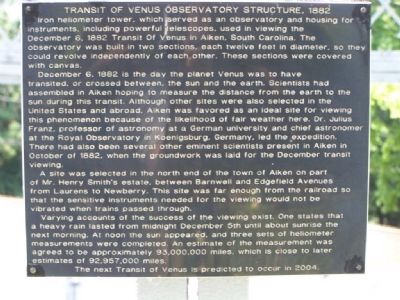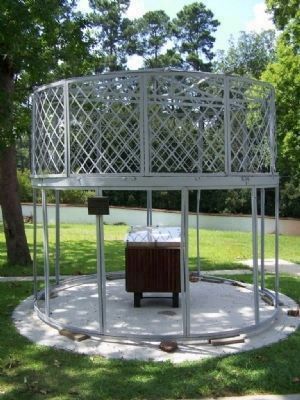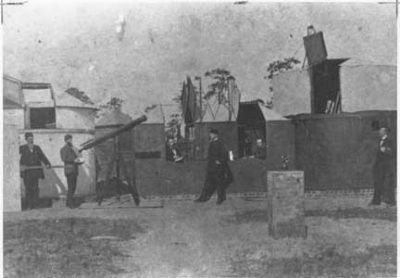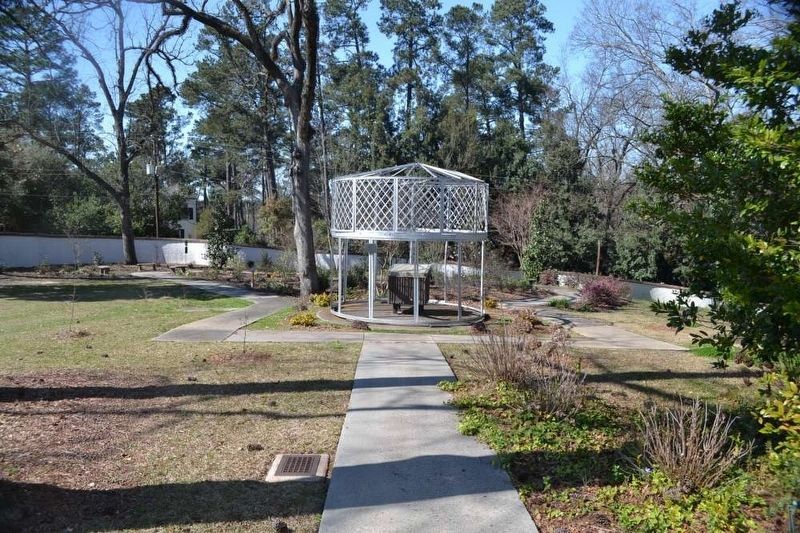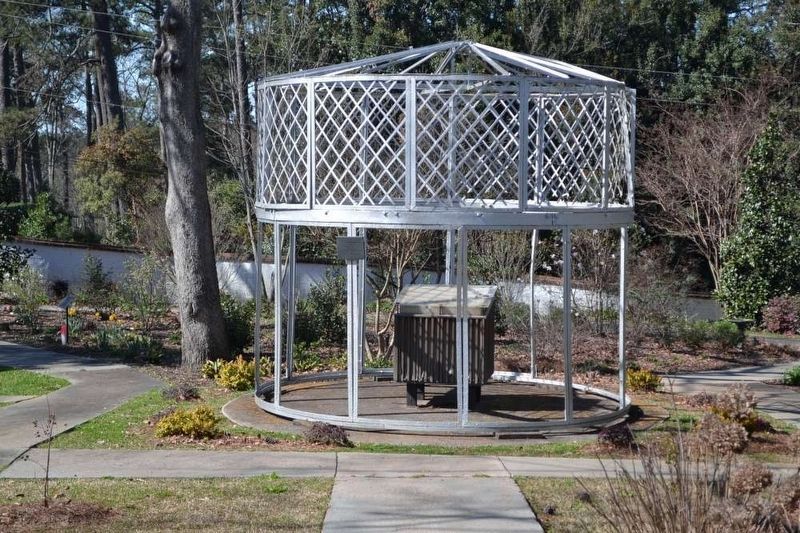Aiken in Aiken County, South Carolina — The American South (South Atlantic)
Transit Of Venus Observatory Structure, 1882
Iron heliometer tower, which served as an observatory, and housing for instruments, including powerful telescopes, used in viewing the December 6, 1882, Transit of Venus in Aiken, South Carolina. The observatory was built in two sections, each twelve feet in diameter, so they could revolve independently of each other. These sections were covered with canvas.
December 6, 1882 is the day the planet Venus was to have transited, or crossed between, the sun and the earth. Scientists had assembled in Aiken hoping to measure the distance from the earth to the sun during this transit. Although other sites were also selected in the United States and abroad, Aiken was favored as an ideal site for viewing this phenomenon because of the likelihood of fair weather here. Dr. Julius Franz, professor of astronomy at a German university and chief astronomer at the Royal Observatory in Koenigsburg, Germany, led the expedition. There had also been several other eminent scientists present in Aiken in October of 1882, when the groundwork was laid for the December transit viewing.
A site was selected in the north end of the town of Aiken on part of Mr. Henry Smith's estate, between Barnwell and Edgefield Avenues from Laurens to Newberry. This site was far enough from the railroad so that the sensitive instruments needed for the viewing would not be vibrated when trains passed through.
Varying accounts of the success of the viewing exist. One states that a heavy rain lasted from midnight December 5th until about sunrise the next morning. At noon the sun appeared, and three sets of heliometer measurements were completed. An estimate of the measurement was agreed to be approximately 93,000,000 miles, which is close to later estimates of 92,957,000 miles.
The next Transit of Venus is predicted to occur in 2004.
Topics. This historical marker is listed in these topic lists: Notable Events • Notable Places • Science & Medicine. A significant historical date for this entry is December 6, 1882.
Location. 33° 33.282′ N, 81° 43.543′ W. Marker is in Aiken, South Carolina, in Aiken County. Marker can be reached from Newberry St SW near New Lane SW. Marker is on the Grounds of Aiken County Museum. Touch for map. Marker is at or near this postal address: 433 Newberry St SW, Aiken SC 29801, United States of America. Touch for directions.
Other nearby markers. At least 10 other markers are within walking distance of this marker. "Banksia" (within shouting distance of this marker); Aiken County Museum (within shouting distance of this marker); Aiken County Courthouse Bell (within shouting distance of this marker); a different marker also named Banksia (about 300 feet away, measured in a direct line); Hitchcock Woods (about 400
feet away); Frederick Ergle Log Cabin (about 400 feet away); Water Trough and Drinking Fountain (about 400 feet away); The One Room Schoolhouse (about 400 feet away); Coker Spring (about 600 feet away); Hofmann (about 800 feet away). Touch for a list and map of all markers in Aiken.
Regarding Transit Of Venus Observatory Structure, 1882. Heliometer - an instrument originally designed for measuring the sun’s diameter, now an instrument used to measure the angular separation of two stars that are too far apart to be included in the field of view of an ordinary telescope
Also see . . .
1. Historical observations of the transit of Venus. (Submitted on August 13, 2008, by Mike Stroud of Bluffton, South Carolina.)
2. Wikipedia entry for Julius Franz. He is most noted for his measurements of features near the lunar limbs. (Submitted on August 13, 2008, by Mike Stroud of Bluffton, South Carolina.)
3. Transit of Venus. A transit of Venus across the Sun takes place when the planet Venus passes directly between the Sun and Earth, obscuring a small portion of the
solar disk. (Submitted on March 14, 2009, by Brian Scott of Anderson, South Carolina.)
Credits. This page was last revised on March 28, 2017. It was originally submitted on August 13, 2008, by Mike Stroud of Bluffton, South Carolina. This page has been viewed 2,619 times since then and 48 times this year. Photos: 1, 2. submitted on August 13, 2008, by Mike Stroud of Bluffton, South Carolina. 3. submitted on August 14, 2008, by Kevin W. of Stafford, Virginia. 4, 5. submitted on March 28, 2017, by Brian Scott of Anderson, South Carolina. • Kevin W. was the editor who published this page.
